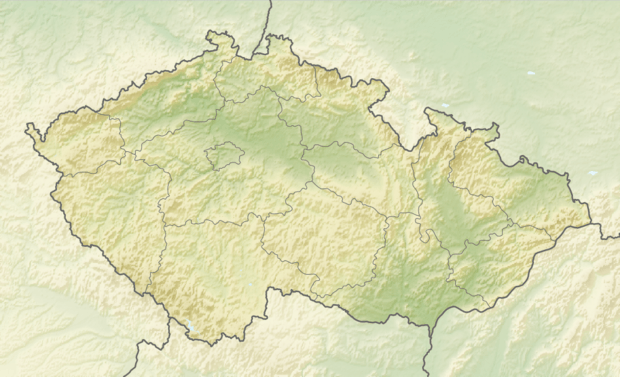Havlíčkův Brod
Havlíčkův Brod (Czech pronunciation: [ˈɦavliːtʃkuːv ˈbrot]),[2] until 1945 Německý Brod (Czech pronunciation: [ˈɲɛmɛtskiː ˈbrot]; German: Deutschbrod) is a district town in the Vysočina Region of the Czech Republic. It is located roughly in the geographical centre of the state, on the Sázava River in the Bohemian-Moravian Highlands and it has a population of about 23,000. It lies in the historical land of Bohemia, near its border with Moravia.
Havlíčkův Brod | |
|---|---|
Town | |
 Havlíček Square seen from the tower of the Church of the Assumption | |
 Flag  Coat of arms | |
 Havlíčkův Brod Location in the Czech Republic | |
| Coordinates: 49°36′21″N 15°34′43″E | |
| Country | Czech Republic |
| Region | Vysočina |
| District | Havlíčkův Brod |
| First mentioned | 1256 |
| Government | |
| • Mayor | Jan Tecl |
| Area | |
| • Total | 64.95 km2 (25.08 sq mi) |
| Elevation | 422 m (1,385 ft) |
| Population (2019-01-01[1]) | |
| • Total | 23,256 |
| • Density | 360/km2 (930/sq mi) |
| Time zone | UTC+1 (CET) |
| • Summer (DST) | UTC+2 (CEST) |
| Postal code | 580 01 |
| Website | www.muhb.cz |
Name
The Czech word Brod means "ford" in English. The settlement became a town in the mid 13th century and for distinction from another places of the same name it was firstly named Smilův Brod ("Smil's Ford") after its founder Smil of Lichtenburk. However, later it became called Německý Brod ("German Ford", German: Deutschbrod) because of its predominantly German population, and as the opposite of Český Brod ("Czech Ford") near Prague. The Germans made up most of the population of the town since 13th until the first half of 15th century. Because of Anti-German sentiment after World War II, the town was renamed Havlíčkův Brod ("Havlíček's Ford") in honor of the 19th century writer and publicist Karel Havlíček Borovský, who was born in nearby village and grew up and studied in the town. It is one of very few examples of personal honorification in Czech toponymy. The rather long official name is commonly abbreviated HB, or colloquially Havlbrod or just Brod (when there's no need to distinguish).
History
Settlement in Brod has been documented as far back as the 12th century. After silver was discovered in the area, the Bohemian nobleman Smil of Lichtenburk (Lichtenburg) invited German miners to settle the area; Brod received its city rights in 1257. Although the townspeople were German-speakers in a predominantly Czech-speaking land, the people of Brod became loyal subjects of the Bohemian crown. In the 13th and 14th centuries it was a center for silver mining, although its importance gradually declined in the latter century. Because the German townspeople supported King Sigismund during the Hussite Wars, Brod was sacked on 22 January 1422 by Jan Žižka. The town was resettled by predominantly Czech-speaking population in 1429 and experienced a cultural flowering during the 16th and 17th centuries. Since 1429 the majority of the town's population was ethnically Czech. Until 1918, the town was part of the Austrian monarchy (Austria side after the compromise of 1867), head of the Deutschbrod - Nemecky Brod district, one of the 94 Bezirkshauptmannschaften in Bohemia.[3]
Brod was industrialized during the 19th century with an emphasis on textiles. Railway came here in 1870 and the station later became an important hub.

After the World War II, the town was renamed Havlíčkův Brod. In the late 1980s Brod's center was declared a national treasure.
Havlíčkův Brod today
- From the city's main plaza a skeleton is readily visible at the top of the town hall's tower.
- The city contains both a medical hospital and a mental hospital.
Nowadays Havlickuv Brod is a calm city although there are many rail stations located there as it's a cross way between many districts.
Transportation
Havlíčkův Brod is both road and railway hub. There are five rail lines leading off the main station: to Kolín and Prague (operating since 1870), to Pardubice (1871), to Brno (1898), to Jihlava (1871) and a local line to Humpolec (1894). Historically, the main line running through the town was Vienna-Znojmo-Jihlava-Kolín, but after WWII the line to Brno was rebuilt, made double-track and electrified, and Praha-HB-Brno became one of main passenger and freight train routes in Czechoslovakia. Though at the break of 20th and 21st centuries its importance dropped, as all international expresses were transferred to the 1st National Railway Transit Corridor (via Česká Třebová), it is still a relevant alternative route.
The town is also a crossing of two major Czech roads, No. 34 from České Budějovice to Svitavy and No. 38 from Mladá Boleslav to Jihlava and Znojmo (and on to Vienna). The D1 motorway Praha-Brno is accessible by both of these roads (exits are about 20 km from HB).
International relations
Twin towns — Sister cities
Brod is twinned with:



- Český Brod, Czech Republic
- Široký Brod, Czech Republic
- Uherský Brod, Czech Republic
- Vyšší Brod, Czech Republic
- Železný Brod, Czech Republic
People
- Pipo of Ozora
- Johann Stamitz
- Ignác František Mara
- Vladislav Vančura
- Jan Zrzavý
- Karel Havlíček Borovský
- Josef Dobrovský
- Karel Barvitius
- František Janák
- Josef Marha
- Bedřich Smetana
- Josef Vašíček
- Radek Martínek
- Jan František Beckovský
- Jan Suchý
- Petr Zelenka (serial killer)
- Vilém Kurz, Sr.
- Vilém Kurz
- Jiří Holík
- Jaroslav Holík
- Jan Novák (ice hockey)
- Ludvík Čelanský
- Antonín Dušek
- Ladislav Kriz
- Radim Zohorna
- Šimon Szathmáry
See also
References
- "Population of municipalities of the Czech republic". Czech Statistical Office. Retrieved 2019-04-30.
- In isolation, Havlíčkův is pronounced [ˈɦavliːtʃkuːf]
- Die postalischen Abstempelungen auf den österreichischen Postwertzeichen-Ausgaben 1867, 1883 und 1890, Wilhelm KLEIN, 1967